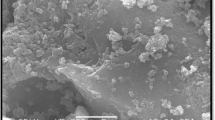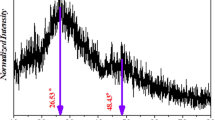Abstract
For the carbon-based glass fabrication/manufacture process, different amounts of pure graphite powder were added up to 100 wt.% of sodium tetraborate oxide (the weight of one mole of the sodium tetraborate is 381.372 g/mol) and then melted at 950 °C for 2 h before fast quenching in the air at RT. The resulted solids were examined by the XRD and SEM techniques, which confirmed the amorphous natures for studied samples. FTIR spectroscopy showed that some C-atoms are shared in the glass network as C–O and CO2. In contrast, the UV–Vis showed that the increase in the graphite contents/impurities causes a red shift in the value of the optical edge and the value of Fermi energy. Also, the increase of the graphite impurities causes a decrease in the bandgap values of both direct and indirect electronic transitions. Both the values of Urbach energy and the metallization indicated an increase in the crystallinity degree as the graphite content increase. A graphite-based glass is a promising material for wide-scale applications.












Similar content being viewed by others
References
A. Terczyńska-Madej et al., Coordination and valence state of transition metal ions in alkali-borate glasses. J. Opt. Mater. 33(12), 1984–1988 (2011). https://doi.org/10.1016/j.optmat.2011.03.046
K. Annapoorani et al., “Investigations on structural and luminescence behavior of Er3+ doped lithium zinc borate glasses for lasers and optical amplifier applications). J. Non Cryst. Solids 447, 273–282 (2016). https://doi.org/10.1016/j.jnoncrysol.2016.06.021
M. Prokic, Lithium borate solid TL detectors. J. Radiat. Measure. 33, 393–396 (2001). https://doi.org/10.1016/S1350-4487(01)00039-7
I.N. Ogorodnikov, N.E. Poryvai, Thermoluminescence kinetics of lithium borate crystals. J. Lumin. 132, 1318–1324 (2012). https://doi.org/10.1016/j.jlumin.2012.01.009
S. Tanabe, Rare-earth-doped glasses for fiber amplifiers in broadband telecommunication. J. C. R. Chim. 5, 815–824 (2002)
P.V. Reddy et al., Optical and thermoluminescence properties of R2O-RF-B2O3 glass systems doped with MnO. J. Non-Cryst. Solids 351, 3752–3759 (2005). https://doi.org/10.1016/j.jnoncrysol.2005.08.039
M.N. Gururaja, A. Hari Rao, A review on recent applications and future prospectus of hybrid composites. Int. J. Soft Comput. Eng. (IJSCE) 1(6), 352–355 (2012)
R.T.D. Prabhakaran et al., Flexural properties of hybrid natural composite-micromechanics and experimental assessment. In: Proceedings of 3rdAsian Conference on Mechanics of Functional Materials and Structures (ACMFMS), C M (2012), vol. 1, pp. 469–472, Indian Institute of Technology, New Delhi
T.D. Jagannatha, G. Harish, Mechanical properties of carbon/glass fiber reinforced epoxy hybrid polymer composites. Int. J. Mech. Eng. Rob. Res. 4(2), 2015. ISSN 2278-0149. www.ijmerr.com
V. Singh et al., Graphene based materials: past, present and future. J. Prog. Mater. Sci. 56, 1178–1271 (2011). https://doi.org/10.1016/j.pmatsci.2011.03.003
A. Geim, K. Novoselov, The rise of graphene. J. Nat. Mater. 6, 183–191 (2007). https://doi.org/10.1038/nmat1849
K.S. Novoselov et al., Electric field effect in atomically thin carbon films. J. Sci. 306, 666–669 (2004). https://doi.org/10.1126/science.1102896
R.D. Dreyer et al., The chemistry of graphene ocide. J. Chem. Rev. Soc. 39, 228–240 (2010). https://doi.org/10.1039/B917103G
G. Wang et al., The chemistry of graphene oxide. J. Chem. (2015). https://doi.org/10.1007/978-3-319-15500-5_3
G. Wang et al., Graphene nanosheets for enhanced lithium storage in lithium ion batteries. J. Carbon 47, 1359–1364 (2009). https://doi.org/10.1016/j.carbon.2009.03.053
X. Li et al., Chemically derived, ultrasmooth graphene nanoribbon semiconductors. J. Sci. 319, 1229–1232 (2008). https://doi.org/10.1126/science.1150878
P. Blake et al., Graphene-based liquid crystal device. J. Nano Lett. 8, 1704–1708 (2008). https://doi.org/10.1021/nl080649i
K.S. Novoselov et al., Room-temperature quantum hall effect in graphene. J. Sci. 315, 1379–1384 (2007). https://doi.org/10.1126/science.1137201
K.I. Bolotin et al., Ultrahigh electron mobility in suspended graphene. Solid State Commun. 146, 351–355 (2008). https://doi.org/10.1016/j.ssc.2008.02.024
X. Li et al., Large-area synthesis of high-quality and uniform graphene films on copper foils. J. Sci. 324, 1312–1314 (2009). https://doi.org/10.1126/science.1171245
K.S. Kim et al., Large-scale pattern growth of graphene films for stretchable transparent electrodes. J. Nature 457, 706–710 (2009). https://doi.org/10.1038/nature07719
S. Bae et al., Roll-to-roll production of 30-inch graphene films for transparent electrodes. J. Nat. Nanotechnol. 5, 574–578 (2010). https://doi.org/10.1038/nnano.2010.132
R.V. Barde, S.A. Waghuley, Preparation and electrical conductivity of novel vanadate borate glass system containing graphene oxide. J. Non-Cryst. Solids 376, 117–125 (2013). https://doi.org/10.1016/j.jnoncrysol.2013.05.034
Z.Q. Li et al., X-ray diffraction patterns of graphite and turbostratic carbon. J. Carbon 45, 1686–1695 (2007). https://doi.org/10.1016/j.carbon.2007.03.038
F.Y. Ban et al., Graphene oxide and its electrochemical performance. J. Electrochem. Sci., 7 (2012) 4345 – 4351. http://psasir.upm.edu.my/id/eprint/25228
A.K. Mishra, S. Ramaprabhu, Carbon dioxide adsorption in graphene sheets. J. AIP Adv. (2011). https://doi.org/10.1063/1.3638178
R. Siburian et al., Effect of N-doped graphene for properties of Pt/N-doped graphene catalyst. J. Chem. Select. 2, 1188–1195 (2017). https://doi.org/10.1002/slct.201601561
R. Siburian et al., New route to synthesize of graphene nano sheets. J. Chem. 34(1), 82–187 (2018). https://doi.org/10.13005/ojc/340120
S. Thirumaran, N. Karthikeyan, Structural elucidation of some borate glass specimen by employing ultrasonic and spectroscopic studies. J Ceram (2013). https://doi.org/10.1155/2013/485317
A. Campopiano et al., Glass fiber exposure assessment during ceiling installation by European Standard EN 689: study of airborne fiber distribution. J. Atmos. Pollut. Res. 3(2012), 192–198 (2012). https://doi.org/10.5094/APR.2012.020
M. Pal et al., Structural characterization of borate glasses containing zinc and manganese oxides. J. Modern Phys. 2, 1062–1066 (2011). https://doi.org/10.4236/jmp.2011.29129
U. Kara et al., Scanning electron microscopy (SEM), energy-dispersive X-ray (EDX) spectroscopy and nuclear radiation shielding properties of [α-Fe3+O(OH)]-doped lithium borate glasses. J. Appl. Phys. A 126, 506 (2020). https://doi.org/10.1007/s00339-020-03683-3
S. Thirumaran, A. Priyadharsini, Structural elucidation of borate glasses by spectroscopic and SEM studies. Asian J Chem 30(6), 1221–1227 (2018)
Y. Cheng et al., Structure and crystallization kinetics of PbO B2O3 glasses. J. Ceram. Int. 33(7), 1341–1347 (2007). https://doi.org/10.1016/j.ceramint.2006.04.025
D. Stentz et al., Analysis of the structure of lead borosilicate glasses using laser ionization time of flight mass spectroscopy. J. Non-Cryst. Solids 293, 416–421 (2001). https://doi.org/10.1016/S0022-3093(01)00837-7
A. Aronne et al., FTIR and DTA study of structural transformations and crystallization in BaO B2O3 TiO2 glasses. Phys. Chem. Glasses 40(2), 63–68 (1999)
J. Iglesias et al., On the tannic acid interaction with metallic iron. J. Hyperfine Interact. 134, 109 (2001). https://doi.org/10.1023/A:1013838600599
A.H. Verhoef, H.W. den Hartog, Infrared spectroscopy of network and cation dynamics in binary and mixed alkali borate glasses. J. Non-Crystalline Solids 182(3), 221–234 (1995)
K.H.S. Shaaban et al., Physical and structural properties of lithium borate glasses containing MoO3. Silicon (2017). https://doi.org/10.1007/s12633-016-9519-4
I. Kashif, A. Ratep, Role of copper metal or oxide on physical properties of lithium borate glass. J. Mol. Struct. 1102, 1–5 (2015). https://doi.org/10.1016/J.MOLSTRUC.2015.07.070
Y.B. Saddeek et al., Optical and structural evaluation of bismuth alumina-borate glasses doped with different amounts of (Y2O3). J. Non-Crystalline Solids 454, 13–18 (2016). https://doi.org/10.1016/j.jnoncrysol.2016.10.023
R.M.M. Morsi et al., “Effect of alkaline earth metal oxides on the dielectric, structural and physico-chemical properties of lithium–zinc–lead-borates. J. Mater. Sci.: Mater. Electron. 27, 4147–4156 (2016). https://doi.org/10.1007/s10854-016-4276-0
S.C. Colak, Role of titanium ions on the optical and thermal properties of zinc borate glass doped with TiO. J. Phys. Chem. Glasses: Eur. J. Glass Sci. Technol. B 58(1), 41–48 (2017). https://doi.org/10.13036/17533562.57.2.067
M. Hosam et al., Influence of the gradual increase of TiO2-impurities on the Optics. Optik (2021). https://doi.org/10.1016/j.ijleo.2021.167543
M. Ghamari, B. Mirhad, Composition dependence of spectroscopic properties and transparency of SiO2-TiO2–Na2O glass in 200–1100 nm. J. Iran. J. Mater. Sci. Eng. (2012). https://doi.org/10.4191/kcers.2017.54.2.01
H.M. Gomaa et al., Optical and structural studies of some zinc calcium borate glasses for optoelectronic device applications. J. Mater Sci.: Mater Electron 32, 9392–9399 (2021). https://doi.org/10.1007/s10854-021-05602-5
M. Nasr et al., Novel thermochromic (TC) and electrochromic (EC) characteristics of the V4O7 liquid crystal for LCDs and versatile optoelectronic applications. J. Mol. Liq. 330, 115620 (2021). https://doi.org/10.1016/j.molliq.2021.115620
H.M. Gomaa et al., The influence of both Zn2+ and Ca2+ on linear and nonlinear optical parameters of some bismuth borate-based glasses. J. Appl. Phys. A 126, 391 (2020). https://doi.org/10.1007/s00339-020-03582-7
S.M. Elkatlawy et al., Structural properties, linear, and non-linear optical parameters of ternary Se80Te(20–x) In chalcogenide glass systems. J. Bol. Soc. Esp. Cerám. Vidr. (2020). https://doi.org/10.1016/j.bsecv.2020.09.007
M.Y. Hassaan et al., Optical properties of bismuth borate glasses doped with zinc and calcium oxides. J. Mater. Appl. 9(1), 46–54 (2020). https://doi.org/10.32732/jma.2020.9.1.46
A.S. Hassanien, I. Sharma, Optical properties of quaternary a-Ge15-x Sbx Te35 thermally evaporated thin-films: refractive index dispersion and single oscillator parameters. J. Optik 200, 163415 (2020). https://doi.org/10.1016/j.ijleo.2019.163415
M.K. El-Mansy et al., Effect of exchange of Bi3+ by Nb5+ on the structural and optical properties of some (BBiNb)2O7CaO oxide glasses. J. Non-crystalline Solids 485(1), 42–46 (2018). https://doi.org/10.1016/j.jnoncrysol.2018.01.036
Acknowledgements
The authors express their appreciation to the Deanship of Scientific Research at King Khalid University for funding this work through the research groups program under Grant Number R.G.P.2/39/40.
Author information
Authors and Affiliations
Corresponding author
Ethics declarations
Conflict of interest
The authors declare that they have no conflict of interest.
Additional information
Publisher's Note
Springer Nature remains neutral with regard to jurisdictional claims in published maps and institutional affiliations.
Rights and permissions
About this article
Cite this article
Gomaa, H.M., Saudi, H.A., Yahia, I.S. et al. Impact of graphite impurities on the structure and optical properties of the sodium borate oxide glass. J Mater Sci: Mater Electron 32, 27553–27563 (2021). https://doi.org/10.1007/s10854-021-07130-8
Received:
Accepted:
Published:
Issue Date:
DOI: https://doi.org/10.1007/s10854-021-07130-8




